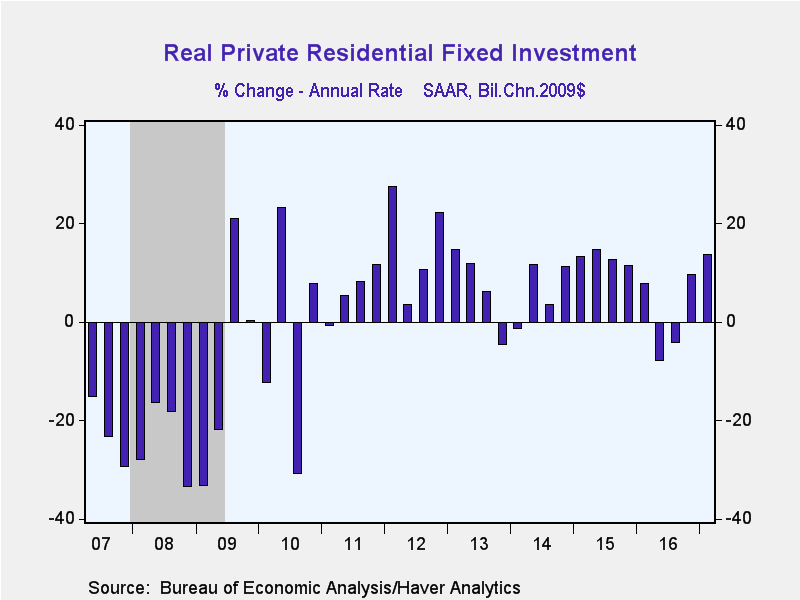 Global| Apr 28 2017
Global| Apr 28 2017U.S. GDP Disappoints: PCE Barely Increases
by:Tom Moeller
|in:Economy in Brief
Summary
Economic growth slowed to 0.7% during Q1'17 following a 2.1% advance during Q4'16. It was the slowest rate of increase in three years and fell short of expectations for a 1.3% advance in the Action Economics Forecast Survey. Weakness [...]
Economic growth slowed to 0.7% during Q1'17 following a 2.1% advance during Q4'16. It was the slowest rate of increase in three years and fell short of expectations for a 1.3% advance in the Action Economics Forecast Survey. Weakness in consumer spending, inventories and foreign trade accounted for growth's deceleration. Pricing power picked up.
The slowdown in real economic growth reflected a 0.3% rise in personal consumption expenditures, its weakest advance since Q4'09. Growth was held back by a 2.5% decline (+7.4% y/y) in durable goods spending which followed three straight quarters of 9%-to-12% growth. Motor vehicle outlays declined 16.1% (+6.3% y/y) and reversed the Q4 jump. Offsetting this decline was a 14.7% surge (13.3% y/y) in recreational goods & vehicle consumption and a 2.6% gain (5.5% y/y) in home furnishings & appliances buying. Nondurable goods outlays increased 1.5% (2.5% y/y), a gain held back by a 7.9% decline in spending (-3.1% y/y) on energy products. Clothing outlays also fell 5.1% (-0.4% y/y), but food purchases rose 4.2% (5.2% y/y). Growth in services purchases of 0.4% (2.1% y/y) was restrained by a 2.3% decline (+0.8% y/y) in housing & utilities outlays. Health care outlays rose 3.2% (4.1% y/y) while recreation spending increased 4.0% (2.1% y/y).
Investment spending offset some of this weakness in personal consumption. Business fixed investment strengthened 9.4% (3.1% y/y) after a 0.9% rise. Structures investment surged 22.1% (7.1% y/y) after declining during all of 2005 and 2006. Producers durable equipment outlays increased 9.1% (0.8% y/y), only the second increase since Q3'15. Industrial equipment outlays jumped 13.0% (6.0% y/y). Information processing equipment investment rose 14.1% (5.4% y/y) and intellectual property product investment gained 2.0% (3.8% y/y). Residential investment surged 13.7% (2.4% y/y).
A reduced rate of inventory investment sapped 0.9 percentage points from overall economic growth and reversed the Q4'16 addition. A 0.1 percentage point contribution to growth from the foreign trade sector reflected a 5.8% rise in exports (3.1% y/y) and 4.1% growth in imports (3.8% y/y).
Government sector outlays declined 1.7% to the lowest level since Q3'15. Federal government investment declined 1.9% (-0.3% y/y) led by a 4.0% drop (-2.2% y/y) in defense spending. Nondefense purchases improved 0.9% (2.5% y/y). State & local government spending fell 0.4% (-0.8% y/y).
The chain type GDP price index increased 2.3%, its fastest rate of growth in three quarters. A 2.0% rise was expected. The PCE price index advanced 2.4%, the quickest rate of increase since Q2'11. The business fixed investment price index rose 1.4% (0.9% y/y), the swiftest rise since Q2'14. Growth in the residential investment price index slowed to 2.4% (4.6% y/y), the slowest growth in a year.
The GDP figures can be found in Haver's USECON and USNA database. USNA contains virtually all of the Bureau of Economic Analysis' detail in the national accounts, including the integrated economic accounts and the recently added GDP data for U.S. Territories. The Action Economics consensus estimates can be found in AS1REPNA.
| Chained 2009 $ (%, AR) | Q1'17 (Advance Estimate) | Q4'16 | Q3'16 | Q1'17 Y/Y | 2016 | 2015 | 2014 |
|---|---|---|---|---|---|---|---|
| Gross Domestic Product | 0.7 | 2.1 | 3.5 | 1.9 | 1.6 | 2.6 | 2.4 |
| Inventory Effect | -0.9 | 1.0 | 0.5 | -0.2 | -0.4 | 0.2 | 0.0 |
| Final Sales | 1.6 | 1.1 | 3.0 | 2.1 | 2.0 | 2.4 | 2.5 |
| Foreign Trade Effect | 0.1 | -1.7 | 0.9 | -0.1 | -0.1 | -0.7 | -0.1 |
| Domestic Final Sales | 1.5 | 2.8 | 2.1 | 2.2 | 2.1 | 3.1 | 2.6 |
| Demand Components | |||||||
| Personal Consumption Expenditures | 0.3 | 3.5 | 3.0 | 2.8 | 2.7 | 3.2 | 2.9 |
| Business Fixed Investment | 9.4 | 0.9 | 1.4 | 3.1 | -0.4 | 2.1 | 6.0 |
| Residential Investment | 13.7 | 9.6 | -4.1 | 2.4 | 4.9 | 11.7 | 3.5 |
| Government Spending | -1.7 | 0.2 | 0.8 | -0.6 | 0.9 | 1.8 | -0.9 |
| Chain-Type Price Index | |||||||
| GDP | 2.3 | 2.1 | 1.4 | 2.0 | 1.3 | 1.1 | 1.8 |
| Personal Consumption Expenditures | 2.4 | 2.0 | 1.5 | 2.0 | 1.1 | 0.3 | 1.5 |
| Less Food/Energy | 2.0 | 1.3 | 1.7 | 1.7 | 1.7 | 1.4 | 1.6 |
Tom Moeller
AuthorMore in Author Profile »Prior to joining Haver Analytics in 2000, Mr. Moeller worked as the Economist at Chancellor Capital Management from 1985 to 1999. There, he developed comprehensive economic forecasts and interpreted economic data for equity and fixed income portfolio managers. Also at Chancellor, Mr. Moeller worked as an equity analyst and was responsible for researching and rating companies in the economically sensitive automobile and housing industries for investment in Chancellor’s equity portfolio. Prior to joining Chancellor, Mr. Moeller was an Economist at Citibank from 1979 to 1984. He also analyzed pricing behavior in the metals industry for the Council on Wage and Price Stability in Washington, D.C. In 1999, Mr. Moeller received the award for most accurate forecast from the Forecasters' Club of New York. From 1990 to 1992 he was President of the New York Association for Business Economists. Mr. Moeller earned an M.B.A. in Finance from Fordham University, where he graduated in 1987. He holds a Bachelor of Arts in Economics from George Washington University.












